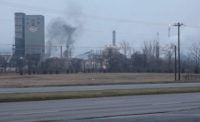...infrastructure take the greatest share, at 26%. Athletic venues in the park and elsewhere account for 16%. Park venue costs are forecast at $1.7 billion, with the $810-million Olympic Stadium, the Aquatic Centre and the $148-million Velodrome and Velopark accounting for $1.4 billion.
Another 16% of ODA’s total budget forecast is allocated to the $485-million Media Centre and the $1.1-billion Olympic Village. The rest is spread between transportation and parkwide projects.
After the Games
Among the other permanent facilities is the Velodrome, with its lightweight, cable-stressed roof. But some venues won’t outlast the games, including the basketball arena. Like a huge egg box, the 12,000-seat facility is a 20,000-sq-m cocoon of stretched, white polyvinyl chloride.
The focus at the site is evolving from big construction to fit-out. The Olympic Stadium looks complete from the outside, while the iconic form of the Aquatic Centre, by London-based “starchitect” Zaha Hadid, is still taking shape.
After the athletes go home, workers will “slice off” the stadium’s roof and upper seating stands, shrinking its 80,000-seat capacity to 25,000 seats. They will clip the wings of the Aquatic Center, removing 15,000 of its 17,500 seats. If all goes as planned, a developer will turn athlete housing into 3,000 residences.
ODA’s Origins
The ODA sprang to life late in 2005 with the appointment of Jack Lemley as chairman and David Higgins as chief executive of the authority. Lemley, principal of the Boise firm that bears his name, led Channel Tunnel contractors 20 years ago.
Higgins, who will leave next year to run the U.K.’s Network Rail,worked on Sydney’s 2000 Olympic Games. Lemley lasted until late 2006, and left making gloomy predictions about the project’s prospects.
He left behind a 2:4:1 strategy, meaning two years to plan, four to construct and one to commission the park.
In its early stages, the job got a lot of negative attention from the media. But as construction contracts started to flow, transforming what had been a blank slate into one of Europe’s largest construction sites, the criticism ebbed.
For the myriad projects, logistics is the key to success, says Epstein. During planning, “we deconstructed the program and turned it into a series of small bits,” he says. But the important part is the program management, which helps ensure everything comes together smoothly, he adds.
The fundamental construction strategy was to procure a delivery partner with a well-defined role, says ODA’s Payne. A few months before Lemley’s departure, ODA appointed a consortium, named CLM, consisting of CH2M Hill Inc., Greenwood Village, Colo.; international U.K. contractor Laing O’Rourke PLC., Dartford; and local construction manager Mace Ltd.
ODA knew it had to get “the right people and nail down a schedule and budget,” says Mike Szomjassy, CLM’s deputy program director. “I’ve done a lot of project management jobs, but this is unique,” he says. At first, “people weren’t sure” how it would work, but it has evolved, he adds.
ODA runs the program with directors overseeing sectors of activity. Under them, ODA sponsors handle individual projects and deal with stakeholders.
Mostly, CLM handles day-to-day management. “Part of the culture here is trusting CLM to do the right thing and be self-regulating,” says ODA’s Payne.
CLM earns fees covering its costs, with profits linked to schedule and budget goals. So far, “we are doing OK,” says CLM’s Szomjassy.
Hot Market
In 2006, ODA launched what was to be one of Europe’s largest building programs into an already hot construction market. “This is probably the sexiest project you could have. We’ve never had any trouble pulling people toward it,” says Mike McNichols, project director for one of the park’s infrastructure design firms, W.S. Atkins PLC., Epsom, Surrey, U.K.
Contractors were less responsive. For example, for the Olympic Stadium, only one consortium submitted a final offer.
ODA worried that bidders would consider the structurally tricky Aquatic Centre a “high-risk project,” says Mike King, design project director with Arup Group Ltd., London. That is one reason the structure was simplified in a redesign.
When boom turned to bust, the market swung in ODA’s favor. Then the worry was about the quality of the low bidders and the financial strength of contractors and suppliers, says Szomjassy.
By then, Payne’s team had devised strategies for procuring the work and operating the intricate logistics needed to serve numerous adjacent projects. With all the players, “it’s the logistics program that makes this site work,” says Payne.
Over 50 contracts, ranging from street cleaning to materials control, provide common services for individual sites.
One major logistics problem includes controlling some 6,000 vehicles expected each day through only two entrances,...








